
laska contractors are accustomed to dealing with unexpected challenges, but no challenge is the same and they all require innovation and resourcefulness. The projects selected for the 2023 Parker, Smith & Feek Excellence in Construction awards were completed by contractors and subcontractors that didn’t let unexpected challenges stand in the way of getting the job done on time and on budget.
The $93 million, three-year project involved a 26-acre site development that included spaces for residential and commercial waste disposal, administration offices, and the trash collection fleet operation, spread across seven buildings and anchored by a 97,000-square-foot tipping facility. According to Davis, the project will increase the municipality’s landfill diversion efforts over the next fifty years, extending the life of the current landfill into the 2070s.
The project is the municipality’s largest Construction Manager at Risk, or CMAR, project. Using CMAR allowed construction to begin early and run parallel with design.
“It allows us to partner with a client early on, figure out their goals, work with the design team, and essentially pull a project forward and deliver a product that is higher quality, more cost effective, and has a shorter duration,” says Davis President Luke Blomfield.
“We started construction twelve months before design was finished,” says Davis Project Manager Jed Shandy.
As part of the project, Davis built three pre-engineered metal buildings, or PEMBs, including one that is definitely Alaska’s largest-span—and likely the nation’s largest-span—pre-engineered metal building. Creative material selections and creative design innovations helped reduce steel costs on the project by $6 million.
The innovation, design choices, and creativity earned Davis an Excellence in Construction: Meeting the Challenge of a Job Over $15 Million award.

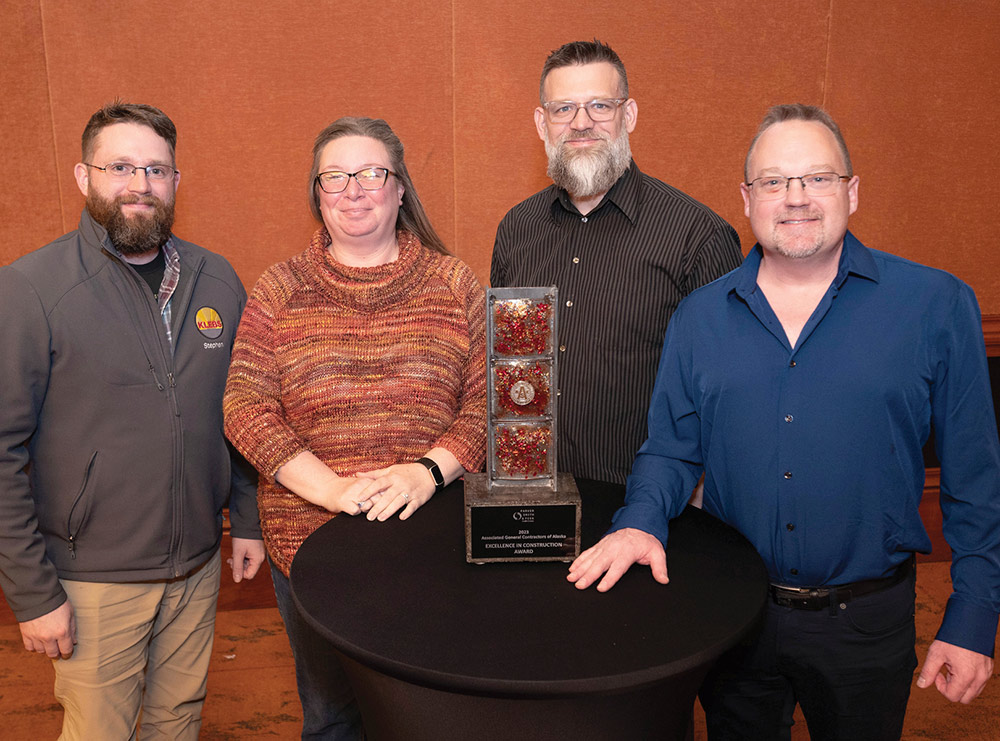
Insulated metal panels contribute to the site’s sustainability by providing excellent thermal resistance, helping to maintain stable indoor temperatures and reducing the need for heating and cooling. Capstone microturbines—highly-efficient microturbines that convert a high percentage of fuel into electricity—are incorporated into the facility. The microturbines’ co-generation capabilities allow the capture and utilization of waste heat for heating, cooling, and other processes.
“We used some innovative energy technologies on the project, co-genning electricity on site and using that to keep the entrance and exit ramps thawed during winter [using] Capstone turbines,” says Shandy. “It’s the first co-gen/backup installation in Alaska.”
Mass Excavation, Inc. won the award for Specialty Contractor for a Job Over $5 Million for its part in the project as the civil scope subcontractor. Mass Excavation was able to reduce concrete overages for slab grading inside buildings from the industry average of up to 3 percent to less than 1 percent, reducing costs for the general contractor and owner. Mass Excavation’s management team also designed a planned sewer line reroute to take advantage of existing excavation, saving an estimated $600,000.
Mass Excavation vice president Mark Erickson says the project was challenging because it was being built while still in design, but Mass Excavation’s crew was able to persevere.
The award is a first for Mass Excavation.
“It continues to show our capabilities to the rest of the world, especially on a sizable project like this,” he says.
The Under $1 Million award was for work the company did building the mechanical system for Chepos Mexican Restaurant’s new Wasilla location. The location includes two cooking lines, high-efficiency air conditioning and natural gas heating systems, and high-efficiency plumbing facilities. Working under an accelerated timeframe added to the challenge, Klebs says: restaurant owners wanted to open by Cinco de Mayo, so work began while snow was still on the ground.
The Between $1 and $5 million award was for KLEBS’ work as a mechanical subcontractor on the Moose Haven (a neighborhood on Joint Base Elmendorf-Richardson) Natural Gas Conversion project. The scope of work included an impressive forty-one duplexes and one single-occupancy home, for a total of eighty-three units. Each building required a new high-efficiency hydronic boiler, water heater, and two unit heaters. The work was done in occupied residences, which required a high degree of sensitivity and planning. Each duplex’s work was done in six to eight days with a two-man crew, which was made possible in part by KLEBS’ decision to prefabricate the boiler systems in its Anchorage shop.
KLEBS President Mike Klebs says it was unexpected to win in both categories, but he sees it as representative of his crew’s good work.
“I have a good team of project managers and staff; that’s a testament to their skills and knowledge and effort. That’s what it really means to me is, I’m able to go back to them and say ‘Hey, good job, you guys,’” he says.
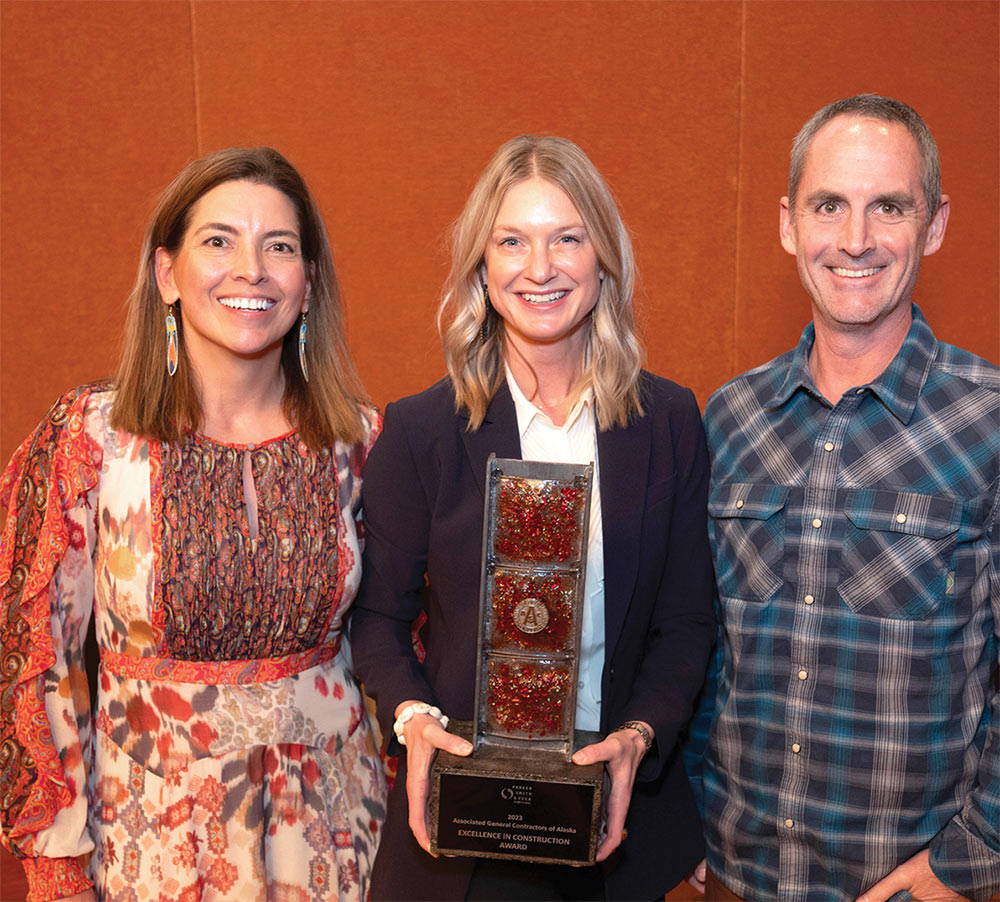
The Barter Island runway was built by the US Air Force in the ‘40s on a narrow spit of land just north of Kaktovik (the easternmost village in the North Slope Borough), forcing residents to move from their historic Kaktovik village site to allow for the construction.
Storms and wave action have eroded land on both sides of the narrow spit of land, requiring several erosion control projects over the years, including a revetment built of gravel-filled steel drums and a geocell cellular confinement grid. A new airport was built in 2015 further inland and the historic runway was abandoned. ChemTrack/Cornerstone was contracted to remove both the concealed and exposed geocell, along with all the steel drum revetment material, a major step in transferring the land back to Kaktovik Inupiat Corporation and allowing residents to travel to and use their historic townsite without health and safety concerns.
ChemTrack President Carrie Jokiel says polar bears at the site were one of the numerous challenges work crews faced on the project.
“Eleven polar bears were sighted at one time,” she says, noting that her crew employed polar bear guards to keep workers safe.
Logistics was another significant factor, says ChemTrack Vice President Jenith Zeigler.
Sea ice is a dominant feature in Kaktovik, where the shore is only free of ice about three months of the year. Even when the shore is free, sea ice can remain near the coast during periods of strong winds. With the prevalence of sea ice, barge service generally happens only once a season.
“It’s such an honor,” Jokiel says of the award.
Knik Construction had just completed a Nome Airport Rehabilitation project when Typhoon Merbok hit Nome in September 2022.
“We had just finished a project there, so we had equipment; we were able to answer the call right away,” says Knik Project Manager Troy Gray. “We were able to jump on it and get a lot of work done in a short amount of time, which was needed because the season was really over by the time the typhoon hit.”
When post-storm damage was assessed, Front Street in Nome had nearly a mile of damage where it was exposed to the Bering Sea, with chunks of asphalt, driftwood, and armor stone filling the street. The Nome-Council Highway was damaged and at one point completely wiped out. Past Cape Nome, miles of historic roadbed was eliminated. Beyond Safety Bridge, another 1,000 feet of isthmus and road were gone.
In days, Knik cleared debris, began repairs and rebuilt roadway. Damage to Safety Bridge was temporarily repaired. In a week, miles of road had been rebuilt. Knik paving crews rebuilt Nome’s Front Street, hauling in material for the base and applying 1,871 tons of asphalt in one week.
“It was an honor to be called to action for an emergency response project like this, working side by side with our Alaska communities,” Knik leaders wrote in the award application.
“It’s a small state and a small contracting community; we’re definitely on the hook to help,” Gray says. “It’s not the first time we’ve done this and it won’t be the last time.”
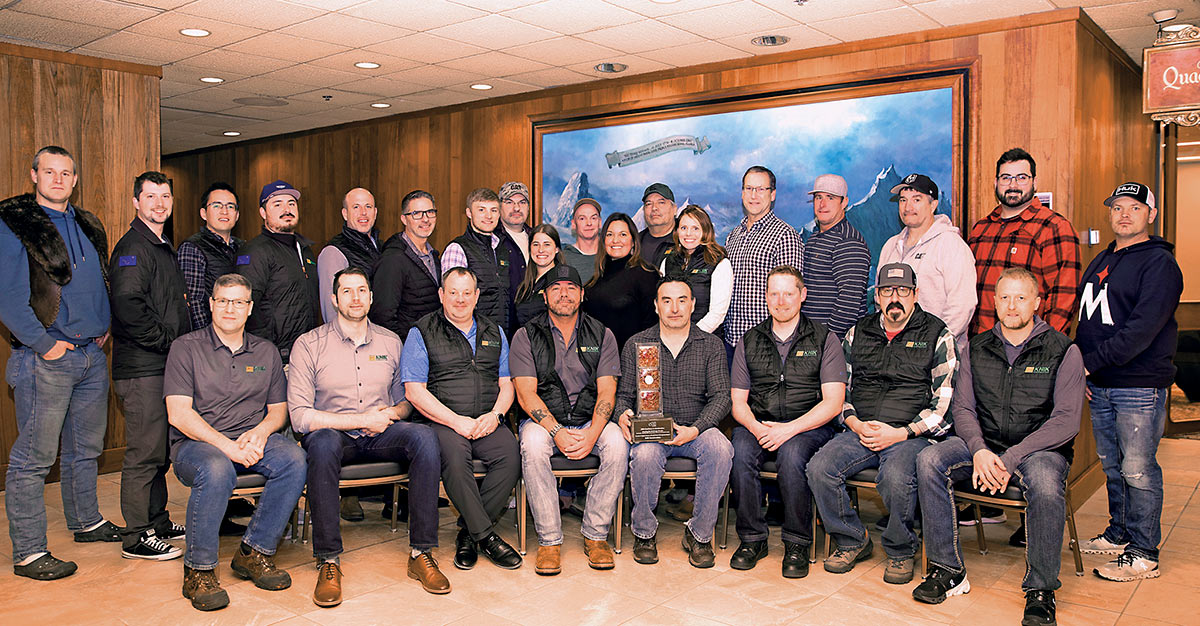
During the bid process for the project, Brice, Inc. conducted bathymetric surveys by boat in the Kotzebue area to identify suitable barge landing areas outside the traditional routes. Brice, Inc. found a landing spot at Cape Blossom, twelve miles south of Kotzebue, and used the spot to barge 275,000 tons of gravel and all insulation board needed for the project. The company then built an ice road the following winter to get the gravel and insulation to the project location. The unique approach helped Brice become the low bidder and ultimately secure the project.
This approach also holds long-term benefits for the community. Brice brought deep-draft barges a mile off the Cape Blossom shore and then lightered the material onto shallow-draft, articulated tug and barges instead of shipping material to Kotzebue and trucking it from there. Brice’s approach meant fewer man-hours shipping each load of gravel and allowed more than 1,000 tons to be placed on each barge load.
Brice also hired a local joint venture company, KIC/Drake, to bring in more gravel and leave a staging area for future Cape Blossom work. Throughout the project, Brice maintained a crew with more than 60 percent local hire.
With the new road, Kotzebue will be able to reduce the cost of goods. The new port will allow deep-draft barges in excess of 22 feet deep to bring goods to the community, allowing more ways of shipping goods to remote villages nearby.
“It was a good project for the community,” said Brice Project Manager Jeff Oshnack.
The project was challenging in part because the cascading escalator is the only way airport users can go between the four levels of the parking garage and the airport terminal, meaning a dust-free pedestrian access route had to be maintained at all times. Not only that, it had to be equipped with temporary lighting, exit signs, fire alarms, and other life-safety requirements.
Timing was an added complication. The glass superstructure was removed in August at the height of the rainy season, and crews had to prevent water from causing damage to the six escalators and one elevator. New structural steel was up in October, but a supply chain issue meant the new glazed curtain wall enclosure was only partially complete; the last pieces did not arrive until summer 2022, but interior architectural finishes had to be complete despite the structure not being weathered in. RHC crews used temporary heat and other protective measures to prevent damage to the new architectural finishes and freezing of the new interior plumbing and fire suppression systems.
RHC crews built a rigid, wood-framed enclosure around all six escalators to protect them from the elements while also providing a working platform on which ladders and scaffolding could be set, allowing workers access to difficult-to-reach areas above the escalators.
“The supply chain issues were more impactful to the project in terms of schedule and interim efforts associated. However, the pedestrian access tunnel through the project limits was also quite complicated as we were forced to complete all facets of the new interior architectural finishes below, above, and on either side of the tunnel, again while maintaining a dust-free environment inside the tunnel. Both of these variables were very challenging to deal with throughout the course of construction,” says RHC Project Manager Kris Squires. “Recognition of RHC’s hard work is very helpful as it serves as positive feedback for management and our employees, and also showcases our abilities to execute complex construction projects which is demonstrated to both past, current, and future clients. It also helps us to evaluate our team’s overall performance in terms of what we did well and where there is room for improvement to ensure a successful project the next time around as well.”
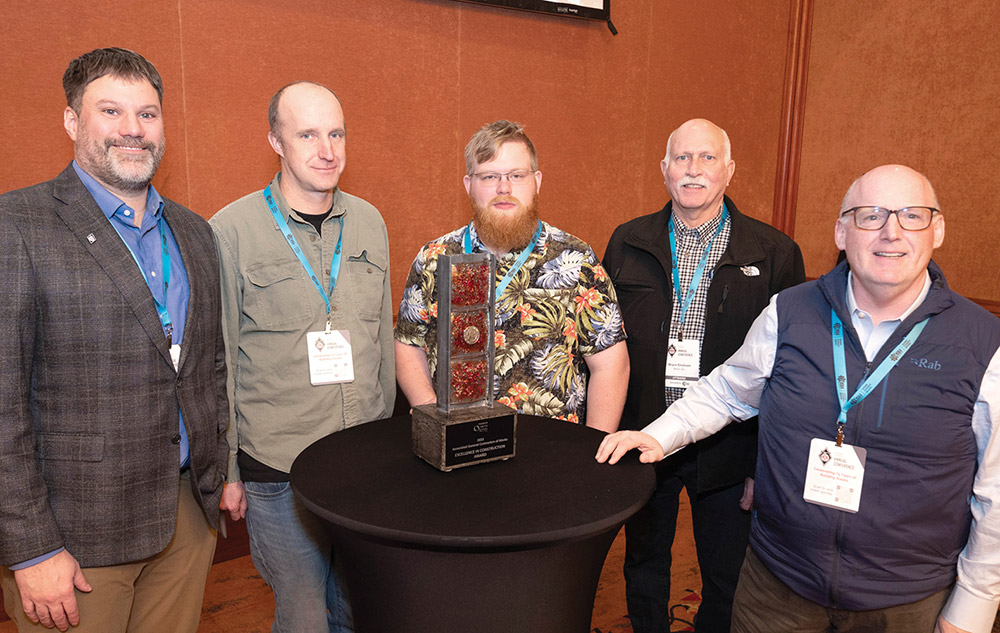
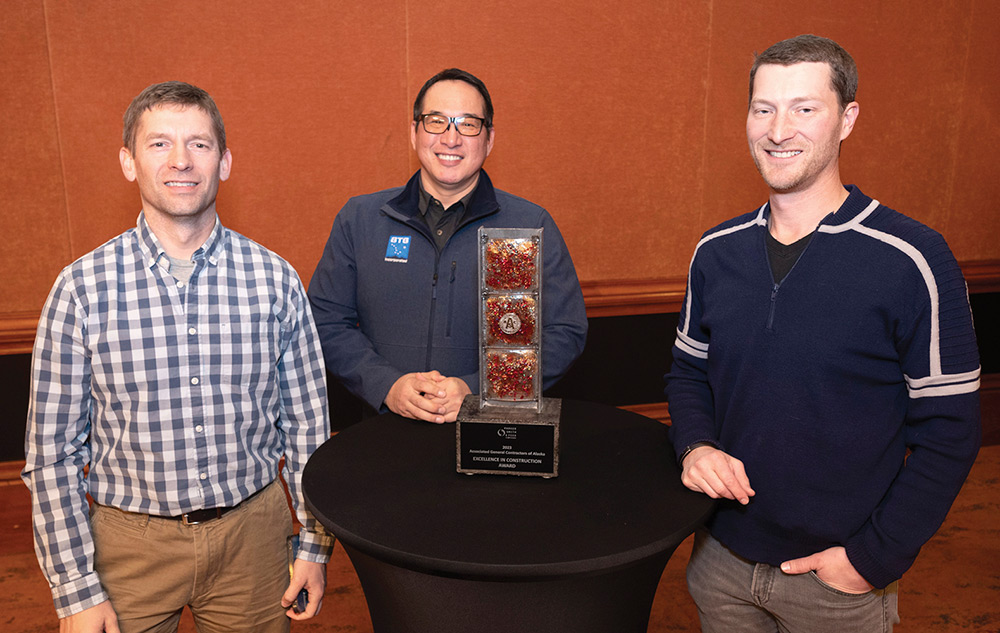
The project added a 75-meter tall wind energy tower in Stebbins that will supply power to both Stebbins and St. Michael. The project is expected to produce a net of 2,529 megawatt hours of wind-powered electricity, displacing more than 104,000 gallons of diesel fuel each year.
STG, Inc. Project Manager Phillip Pletnikoff says the logistics and mobilization made the project challenging. Stebbins is on the west coast of Alaska, about 100 miles southeast of Nome, and is only accessible by sea or air. Sea ice blocks the community in for about half the year.
“We brought in a specialized crane, but in order to mobilize that crane through town, through the roads, we really had to beef up their roads. We had to do a lot of civil work … just to get the crane to the location,” Pletnikoff says.
STG sourced the crane from California specifically for this job. It was moved to Seattle in twenty-two truckloads, put on a barge to Bethel, and finally transported to Stebbins. STG needed another crane to offload the specialized crane, so the company staged multiple mobilizations to get the project going.
“The mobilization effort to deliver the wind components, main crane, support equipment, and materials required STG to coordinate a total of six barge and landing crafts” for the project, according to the STG award application.
A separate challenge were the Thermo helix-pile, special pipes used to passively freeze the substrate below a foundation, which had to be installed during the middle of winter so water from the saturated ground wouldn’t fill the hole and to provide time for the thermopile to freeze the surrounding ground below the twenty-two-story tower erected above it. To keep the permafrost frozen, STG needed to complete civil construction as soon as the snow melted but before the ground thawed.
STG persevered, and its commitment to good planning, good communication among team members and with stakeholders, and flexibility brought success. Pletnikoff says he hopes this award will show STG’s continued ability to take on difficult projects and succeed.
“It’s looking forward to projects like this and being able to continue to deliver these on time and on budget,” says Pletnikoff. “We put these wind towers in all over the west coast and in different locations, but … in the construction atmosphere we are in, we still want to be able to deliver more projects like this.”